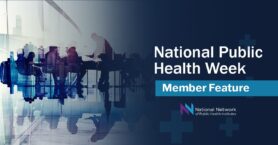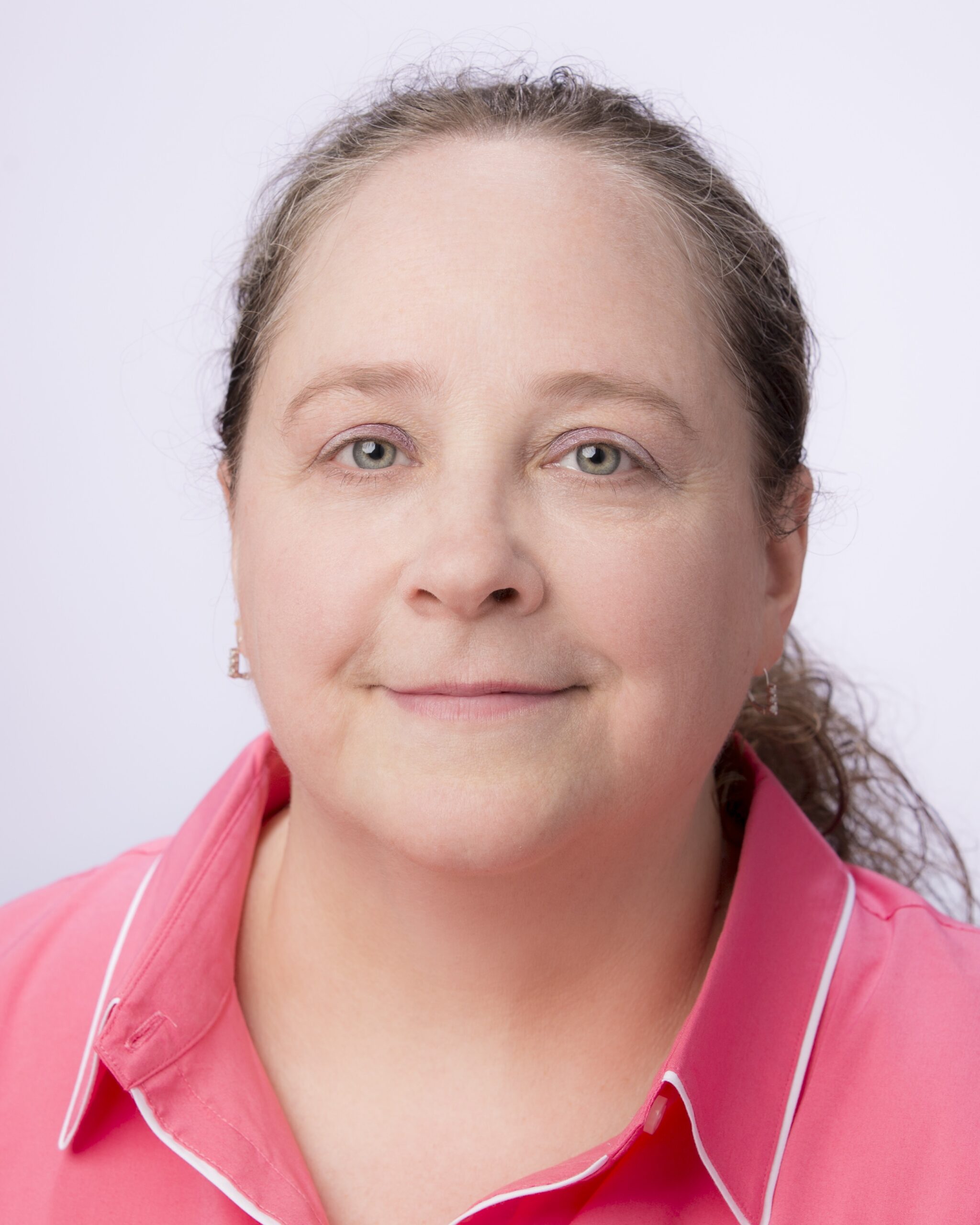#ThankYouPublicHealthInstitutes: Danielle Louder and Elizabeth Foley
- By: National Network of Public Health Institutes
- Date
JOIN US IN CELEBRATING PUBLIC HEALTH TRAINERS ACROSS THE COUNTRY DURING NATIONAL PUBLIC HEALTH WEEK
Name: Danielle Louder and Elizabeth Foley
Title: Co-Directors
Organization:
How did you get into training in public health?
Danielle: Training has been part of essentially every role that I’ve ever taken on as a public health professional. Starting with my first job out of college, as an Environmental Health Inspector for the City of Bangor, Maine, I quickly learned that spending time to educate stakeholders on the “why” behind specific laws and health and safety requirements was a lot more effective than just enforcing the rules without building knowledge and taking into consideration how they may impact people in the field. I’ve since had roles that were primarily focused on education, including a community health educator and a wellness coach, and others where education wasn’t necessarily in my job description, but still served a core function in my own success as well as others. For example, now as Co-Director of MCD Public Health, and Director of a federally funded Telehealth Resource Center, education and training are integral components in maintaining a strong team focused on achieving our organizational mission, and to effectively engaging partners and stakeholders as we develop the workforce through both traditional and new training and education approaches.
Elizabeth: Early in my public health career, I had the fortunate opportunity to work alongside leaders and mentors in global public health. As the founding Director of the Program for Infectious Disease and Social Change at Harvard Medical School, I was immersed in research, advocacy and clinical service projects for some of the world’s most vulnerable communities. During this time, I began my involvement in Community Health Worker (CHW) training in Haiti, Peru, and Boston. CHWs were our first-line staff delivering services to support patients with HIV/AIDS, TB, and drug-resistant TB. As part of this outreach work, our own program team members received training to foster empathy, inclusion, collaboration, and a sense of leadership in all staff. Those bedrock values continue to guide me in my career and as a mentor to others in public health today.
How do you approach training adults for continued learning?
Danielle: Learning about your students, including their interests, needs and capacities, before, during and after training is vital to everyone’s success. For example, identifying baseline knowledge (e.g. content area) and skill sets (e.g. using technology) will help ensure that you’re not training below or above the baseline, but rather are meeting students where they’re at, and building on their current scope in a particular focus area. Simple surveys, needs assessments and other tools can be used throughout the course of training to ensure you’re hitting the mark with respect to keeping students engaged and learning, and for improving future trainings. And just because we’re adults doesn’t mean we’re okay with monotonous slide decks filled with bullet points and data. Allowing time for interactive learning and sharing of skills and resources among students and teachers, such as with the case-based learning model used in Project ECHO, can be highly effective for all ages of learners. It’s also important to use multiple modalities (didactic, virtual, etc.) and to accommodate for specific student needs, in order to encourage learning across a diverse population. And remember that making assumptions almost never pays off – for example, some older adults are extremely tech savvy, and some physicians may struggle with basic technology. We each bring unique strengths and weaknesses, and there’s always more we can learn!
Elizabeth: Whether we are delivering in-person, online, self-paced, or a hybrid model, trainings need to be interactive using a combination of didactic instruction, case studies/scenarios, open inquiry, role-playing, and group exercises. In addition, when developing trainings, the target group must be actively involved in the design process. For example, CHW training is a key workforce development strategy for our public health institute. MCD Public Health collaborates with numerous state health departments, subject matter experts, and community health workers to develop the training content. Community Health Workers are surveyed and interviewed about their needs and interests, and they participate in beta testing to ensure all training is appropriate, informative, engaging, and comprehensive. And because CHWs have asked, this spring, MCD Public Health will launch a fully online hybrid core competency training for community health workers. The training includes self-paced modules, homework assignments, and live virtual interactive sessions. Also, as COVID has expanded the use of telehealth, our e-learning team and the Northeast Telehealth Resource Center are developing a community health worker telehealth technology training.
What has been the biggest challenge related to training and workforce development over the last year?
Danielle: Given MCD Public Health’s significant expertise and existing infrastructure in virtual training and telehealth, we were well prepared to quickly pivot to remote work and training, including education we had historically offered in-person. The most significant challenges we experienced included:
- Adapting virtual training for those who didn’t have adequate internet and/or devices was a significant issue – lack of access and equity in rural and underserved areas were further exacerbated under the pandemic, however implementing approaches like telephonic education and developing self-paced toolkits which don’t require nearly as much bandwidth as live video, were very helpful solutions
- The sheer volume and immediate need for training and technical assistance was very challenging – for example, thousands of providers across all healthcare disciplines needed to transition to telehealth essentially overnight, to ensure ongoing access to care for patients, and they needed effective tools and training to do so. In order to meet these needs with existing staff resources, we had to work smarter not harder, and we did this by offering training that reached many stakeholders at once, like regular virtual office hours, state-wide town halls, Project ECHOs, and eTraining tools for hundreds of health professions students across multiple universities, who were unable to complete in-person field and clinical experiences due to COVID.
Elizabeth: I would agree with Danielle that volume and immediate need for training and technical assistance was very challenging. Though MCD Public Health was fortunate to have an existing structure for online training. Our Global e-Training and Techincal Assitance Center (GETTACH) had been up and running for some time, and we could quickly launch trainings for health care, public health, community-based partners and expand our offerings to community health workers. We have team members and CHWs who helped translate our COVID trainings in Spanish, French and Arabic.
What topics or skills have you found lack training opportunities but are needed in the field of public health?
Danielle & Elizabeth: While a fair amount of energy has been dedicated to bridging public health and healthcare, and this topic is included in public health training curricula across the U.S., there seems to be ample room for training across the integration of public health with other sectors and disciplines – for example, public health and economic/community development. And while it may be more of a workforce shortage issue than a lack of available training, we are now seeing a massive gap in those skills which are vital to an effective response to pandemics, disasters and other public health crises, including infection control specialists, surveillance epidemiologists and others. Given the heightened awareness and value placed on public health throughout the course of the COVID-19 pandemic, it will be important to leverage this opportunity to make all public health training more accessible and affordable, to ensure a workforce that is equipped to address the key public health issues of tomorrow.
What advice do you have for others in training or workforce development?
Danielle: These may be obvious to many, but are some of the most important things I’ve learned along the way:
- Be as willing to learn, as you are to teach. When your audience recognizes that you’re interested in what they have to share, and are open to adapting your own lens to fit new ideas and approaches, everyone wins.
- It’s true that “you get more flies with honey” – whether you’re training students, staff, providers, consultants or others, taking a respectful approach and recognizing that the behavior change or new skill that you’re asking someone to implement may be difficult, or is lower on their current hierarchy of needs, is likely to result in a more positive and patient learner, even if it takes a bit longer for them to master the content or skill.
- Don’t be afraid to change things up – whether it’s customizing a training for a particular group, keeping up with trends in the literature, or trying new modalities and interactive approaches, both you and your students will mutually benefit by keeping things fresh.
Elizabeth: I would add that no training should be designed without the input of stakeholders and end-users. “Nothing About Us, Without Us” is a principle that should be applied in any training development. All trainings should capture evaluation data on utilization, effectiveness, practical application, user satisfaction, and durability. The material should be fresh and up-to-date, and delivery methods meet the needs of the target audience.



 Subscribe To Our Communications
Subscribe To Our Communications